Can we imagine a life for ourselves where nothing ties us to the material world? No family, no possessions, no desires—only devotion, discipline, and a quest for spiritual liberation? This is the life of the Naga Sadhu, ancient ascetics who walk a path so rare and difficult that we cannot even begin to understand. Rooted deeply in Hinduism, Naga Sadhus are not only regarded for their spiritual austerity but also for their warrior-like spirit. Known for their distinctive attire (or lack thereof), the Naga Sadhu’s presence at the Maha Kumbh Mela, one of the world’s largest spiritual gatherings, is an awe-inspiring sight.
The Life Of A Naga Sadhu

Naga Sadhus are respected ascetics who commit their lives to spiritual practices, renouncing all worldly attachments. Their origins go back thousands of years, with their history even displayed in artefacts from Mohenjo-Daro, one of the world’s oldest civilisations. These relics show Naga Sadhus worshipping Lord Shiva in his Pashupatinath form.
The word “Naga” is derived from the Sanskrit term for “mountain,” or someone who resides around mountains. It symbolises their ascetic lives lived away from society. They leave their families, homes, and personal belongings, adopting a life of celibacy and simplicity. The initiation into the order generally starts at a young age and spans many years. During the first six years, they live in celibacy and meditation. After twelve more years of strict practice, they are finally recognised as Naga Sadhus.
Their attire is minimal—many are seen wearing only a small piece of saffron cloth. They also cover themselves with holy ash (Vibhuti), which symbolises renunciation and purity. They live in caves or under the open sky and travel from place to place in search of spiritual enlightenment. They spend most of their time meditating, worshipping, and following strict rituals to achieve Moksha.
Naga Sadhus are both spiritual seekers and warriors. Their main mission has been to protect the principles of Sanatan Dharma while also safeguarding Shiva’s temples from invaders.
Also Read: Maha Kumbh Mela 2025: Key Snan Dates And Essential Safety Tips For A Sacred And Safe Pilgrimage
Naga Sadhus At Maha Kumbh Mela

The Maha Kumbh Mela is one of the largest and most sacred religious gatherings in India, attracting millions of pilgrims every 12 years to four key locations—Allahabad (Prayagraj), Haridwar, Ujjain, and Nashik. The Naga Sadhus play a major role in this extraordinary event.
Naga Sadhus take shahi snan in the river, which is believed to purify them and wash away their sins. Before this bath, they participate in grand processions and display their martial prowess with swords, tridents, and other weapons.
Traditionally, these warrior-ascetics received training to defend Hindu temples and other holy places. They wielded weapons and were often called upon to defend against the Mughal invasions. They are also known to defeat enemy forces, including Emperor Aurangzeb’s troops. This warrior aspect remains alive today.
As we approach the Maha Kumbh Mela in 2025, the Naga Sadhus will once again take centre stage.
Cover Image Courtesy: Canva
For more such snackable content, interesting discoveries and the latest updates on food, travel and experiences in your city, download the Curly Tales App. Download HERE. First Published: January 10, 2025 12:49 PM




